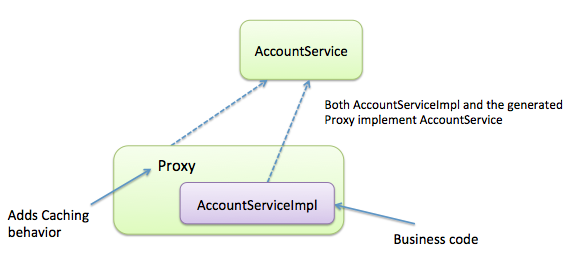領先一步
VMware 提供培訓和認證,以加速您的進步。
瞭解更多在 Spring 框架中,許多技術特性都依賴於代理的使用。我們將使用三個示例深入探討這個主題:事務、快取和 Java 配置。
本部落格文章中顯示的所有程式碼示例都可以在我的 github 帳戶上找到。
@Service
public class AccountServiceImpl implements AccountService {
//…
//Not specifying a transaction policy here!
public void create(Account account) {
entityManager.persist(account);
}
}
由於方法“create”不是事務性的,因此很可能會丟擲異常(因為不應在事務之外持久化此 Account 物件)。
@Service
public class AccountServiceImpl implements AccountService {
@PersistenceContext
private EntityManager entityManager;
@Transactional
public void create(Account account) {
entityManager.persist(account);
}
}
這是相應的 Spring 配置
<bean id="transactionManager">
<property name="entityManagerFactory" ref="entityManagerFactory" />
</bean>
<tx:annotation-driven/>
在 Spring 的通用配置中,我們使用了 <tx:annotation-driven />。 這意味著所有 @Transactional 註解都應在啟動時掃描,並且目標方法應變為事務性的。 那麼事務行為在哪裡發生呢?
在啟動之前,我們仍然擁有與之前相同的檔案
在啟動時,會建立一個新類,稱為代理。 此類負責新增事務行為,如下所示
生成的代理類位於 AccountServiceImpl 之上。 它向其新增事務行為 [1]。
那麼如何確保確實正在使用代理? 為了您自己的理解,回到程式碼中並親眼看到您確實在使用代理非常有趣。
一種簡單的方法是打印出類名
AccountService accountService = (AccountService) applicationContext.getBean(AccountService.class);
String accountServiceClassName = accountService.getClass().getName();
logger.info(accountServiceClassName);
在我的計算機上,它顯示以下輸出
INFO : transaction.TransactionProxyTest - $Proxy13
此類是動態代理,由 Spring 使用 JDK 反射 API 生成(更多資訊請參見 此處)。
在關閉時(例如,當應用程式停止時),代理類將被銷燬,並且您將僅在檔案系統上擁有 AccountService 和 AccountServiceImpl
@Controller public class AccountController { private AccountService accountService;
private void setAccountService(AccountService accountService) { this.accountService=accountService; }
//… }
<a href="http://blog.springsource.org/wp-content/uploads/2012/05/proxy-and-target1.png"><img class="aligncenter size-full wp-image-11128" title="proxy-and-target" src="http://blog.springsource.org/wp-content/uploads/2012/05/proxy-and-target1.png" alt="" width="316" height="255" /></a>
</div>
<div>
The attribute accountService is of type AccountService (interface). The variable dependency is on the interface type AccountService, not the implementation type, which reduces the coupling between classes. This is a best practice.
As seen before, both AccountServiceImpl and the generated Proxy implement the interface AccountService.
• If there is a proxy, Spring injects the proxy
• If not, Spring injects the instance of type AccountServiceImpl.
</div>
<h3><a name="cache">Caching</a></h3>
<div>
Declarative caching is a new feature in Spring 3.1 that works like Spring’s declarative transaction support.
The @Cacheable annotation should be used in that way:
</div>
<div>
```java
public class AccountServiceImpl implements AccountService {
@Cacheable(value="accounts", key="#id")
public Account findAccount (long id) {
// only enter method body if result is not in the cache already
}
}
您還應該在 Spring 配置中啟用快取,如下所示
<cache:annotation-driven />
這是預期的結果
accountService.findAccount (1); // Result stored into cache for key “1”
accountService.findAccount (1); // Result retrieved from cache. Target method not called.
accountService.findAccount (2); // Result stored into cache for key “2”
在執行時,代理用於新增快取行為。
 注意:Spring 3.1 嵌入了一個相當簡單的快取實現。 通常建議使用另一個實現,例如 ehcache。 在此處提供的示例應用程式 (https://github.com/michaelisvy/proxy-samples) 中,您將找到一些使用嵌入式快取實現和 ehcache 的示例。
注意:Spring 3.1 嵌入了一個相當簡單的快取實現。 通常建議使用另一個實現,例如 ehcache。 在此處提供的示例應用程式 (https://github.com/michaelisvy/proxy-samples) 中,您將找到一些使用嵌入式快取實現和 ehcache 的示例。預設情況下,如果您的 bean 未實現介面,Spring 將使用技術繼承:在啟動時,將建立一個新類。 它從您的 bean 類繼承並在子方法中新增行為。
注意:本節需要一些 Spring 中 Java 配置的背景知識。 如果您不熟悉這種新的配置樣式,請隨時跳過它。
@Configuration public class JavaConfig {
@Bean public AccountService accountService() {
return new AccountServiceImpl((accountRepository()); } @Bean public AccountRepository accountRepository () { //… }
}
Spring calls the method accountService() every time it needs to wire an instance of the bean “accountService” and this one returns a “new” object of type AccountService. If 10 beans are using a dependency of type AccountService, this method is called 10 times.
However, no matters the Spring configuration has been made using Java Configuration or not, every bean should be a singleton by default. How is that possible and where is the magic happening?
This diagram explains how things work internally:
</div>
<div><a href="http://blog.springsource.org/wp-content/uploads/2012/05/java-config.png"><img class="aligncenter size-full wp-image-11131" title="java-config" src="http://blog.springsource.org/wp-content/uploads/2012/05/java-config.png" alt="" width="507" height="328" /></a></div>
<div>
So the Proxy is adding behavior there. In the case that your bean should be a singleton, the action to turn your Plain Old Java Object into a singleton is performed by a child class (Proxy).
</div>
<div>
<h3>Conclusion</h3>
We’ve seen some use-cases on how proxies are used inside the Spring framework. There are many other examples: Aspect Oriented Programming, Security (using Spring Security), thread safety, scopes, etc…
If you would like to know more on the impact on performance when using proxies, you can read <a href="http://blog.springsource.org/2007/07/19/debunking-myths-proxies-impact-performance/">Alef Arendsen’s blog entry here</a>.
</div>
<div>
<hr size="1" />
<div><a name="note">[1]</a>to be exact: the proxy class does not contain the transaction code internally. It delegates transaction handling to some classes that are part of the Spring framework. Spring will then handle transactions according to the Transaction Manager you have declared.
</div>
</div>